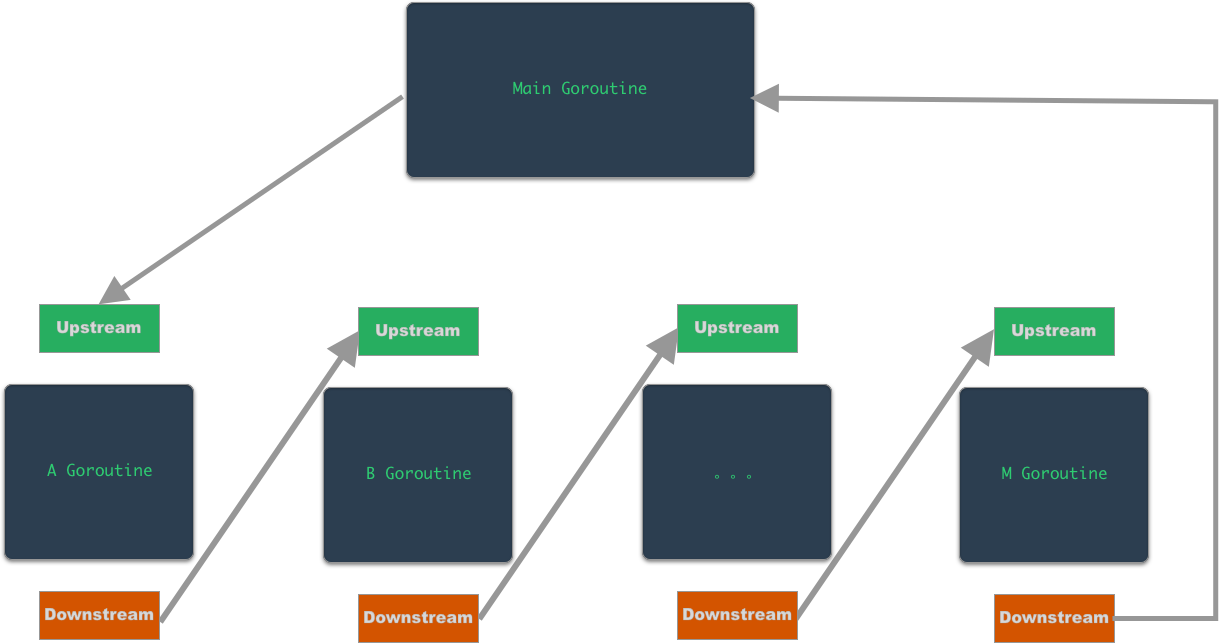关于线程同步操作的一道面试题
前言
前两天在 V2EX 上发现了一道好玩的面试题,兴致冲冲地写了答案出来,并发到了 V2EX 上。结果发现自己实现的思路完全是错误的,遂把上篇文章推翻,重新写一篇。
问题描述及解析
问题描述
编写一个程序,开启 3 个线程 A,B,C,这三个线程的输出分别为 A、B、C,每个线程将自己的输出在屏幕上打印 10 遍,要求输出的结果必须按顺序显示。如:ABCABCABC....
为了能够踩到更多的坑,我把上述问题升级了一下,线程数量和打印次数不是一个固定的值,具体如下:
- 编写一个程序,开启 N 个线程 A,B,C...,这 N 个线程的输出分别为 A、B、C...,每个线程将自己的输出在屏幕上打印 M 遍,要求输出的结果必须按顺序显示。如:ABC...ABC...ABC...
- 其中 N <= 1000, M <= 1000
注意:
- 输出要在各自的线程中输出,不能在主线程中输出
题目解析
引用自 V 友 @hjc4869
这个问题本质上是在实现同步,而不是互斥。同步强调的是做事的先后顺序而不是多线程访问资源的冲突。虽然二者是包含关系并且可以互相实现,但是如果这里第一眼看到题就只是想到用 lock/mutex 而不是 semaphore/channel 去实现,那么显然是对后者的应用不熟,面试要挂的
利用 Channel 做信号量的解法
使用信号量的话,这个题的解题思路就很简单:
- 创建 N 个 Goroutine 执行输出操作。
- 每个 Goroutine 的具体操作可用以下伪代码来表示:
def echo(threadNum, Upstream, Downstream):
for i in range(M):
wait Upstream // 等待上游的信号
print(threadNum)
signal Downstream // 给下游发送信号
其中Upstream 和 Downstream 都表示信号量,A Goroutine 的 Downstream 是 B Goroutine 的 Upstream,依此类推,所有 Goroutine 会形成一个链式的关系。
可以使用下图来表示:

具体代码如下:
package main
import (
"fmt"
"log"
)
var (
N = 5
M = 2
)
func main() {
var wait, sig, firstWait, lastSig chan struct{}
wait = make(chan struct{})
firstWait = wait
for i := 0; i < N; i++ {
sig = make(chan struct{})
lastSig = sig
go echo(i, wait, sig)
wait = sig
}
for i := 0; i < M; i++ {
firstWait <- struct{}{}
<-lastSig
}
close(firstWait)
_, ok := <-lastSig
if ok {
log.Fatalln("Channel not closed")
}
// Out
// 0: A
// 1: B
// 2: C
// 3: D
// 4: E
// 0: A
// 1: B
// 2: C
// 3: D
// 4: E
// 0: A
// 1: B
// 2: C
// 3: D
// 4: E
// Close A
// Close B
// Close C
// Close D
// Close E
}
func echo(threadNum int, wait chan struct{}, sig chan struct{}) {
threadName := string('A' + threadNum)
for _ = range wait {
fmt.Printf("%d: %s\n", threadNum, threadName)
sig <- struct{}{}
}
close(sig)
// 这句是我打印出来为了确认所有的 Goroutine 已经关闭了,实际不需要
fmt.Println("Close", threadName)
}
FanIn 的方式
根据题目要求来看,在主线程中输出结果,有些不符合要求,但有个答案的实现很有意思,我就也放上来了
经 V 友 @Mark3K 的补充,还可以使用多个 channel 执行扇入(Fan In)操作,避免使用锁。
首先说一下扇入的定义,Go blog 中是这样描述的:
A function can read from multiple inputs and proceed until all are closed by multiplexing the input channels onto a single channel that's closed when all the inputs are closed. This is called fan-in.
通过将多个输入 channel 多路复用到单个处理 channel 的方式,一个函数能够从多个输入 channel 中读取数据并处理。当所有的输出 channel 都关闭的时候,单个处理 channel 也会关闭。这就叫做扇入。
在维基百科中描述的逻辑门的扇入如下(大家也可以参考这个来理解 Go 中的扇入):
Fan-in is the number of inputs a logic gate can handle. For instance the fan-in for the AND gate shown in the figure is 3. Physical logic gates with a large fan-in tend to be slower than those with a small fan-in. This is because the complexity of the input circuitry increases the input capacitance of the device. Using logic gates with higher fan-in will help reducing the depth of a logic circuit.

逻辑门中的扇入定义: 一个逻辑门将多个输入处理成一个输出,它能够处理的输入数量就叫做扇入。
理解了扇入的概念后,上述问题的答案也呼之欲出了。我们可以为A,B,C,...这 N 个 Goroutine 创建 N 个 channel。然后通过一个 FanIn 函数将 N 个 channel 的输出输入到一个 channel 中。具体代码如下:
package main
import "fmt"
var (
N = 5
M = 5
)
func gen(v string, times int) <-chan string {
ch := make(chan string)
go func() {
defer close(ch)
for i := 0; i < times; i++ {
ch <- v
}
}()
return ch
}
func fanIn(times int, inputs []<-chan string) <-chan string {
ch := make(chan string)
go func() {
defer close(ch)
for i := 0; i < times; i++ {
for _, input := range inputs {
v := <-input
ch <- v
}
}
}()
return ch
}
func main() {
times := M
inputs := make([]<-chan string, 0, N)
for i := 0; i < N; i++ {
threadName := string('A' + i)
inputs = append(inputs, gen(threadName, times))
}
for char := range fanIn(times, inputs) {
fmt.Println(char)
}
}
使用锁的解决方案
使用锁并不是这个问题的正确解决思路,甚至会将人的思维带入歧途,所以不推荐大家使用锁解决。
这是我之前写的旧文,线程同步操作面试题使用锁的解法,个人觉得某些地方还有一些参考价值,请大家酌情阅读。
使用 AtomicInteger 的解决方案
使用AtomicInteger并不是一种好的解决方案(因为这个解法让 CPU 持续空转),但是通过这个解法我们可以了解到 Go 调度器阻塞的一个陷阱,所以也把这种解法放了上来,感兴趣的朋友可以查看我的另一篇文章 Go 调度器的一个无法执行陷阱。
1
usingnamespace 2019-04-15 01:10:54 +08:00 via iPhone
讲挺明白
|
2
reus 2019-04-15 09:46:23 +08:00
go 编译器 1.13 版本会引入基于信号的 goroutine 抢占调度,runtime.Gosched 不需要了
|